 Low
voltage circuit breaker
Low
voltage circuit breaker
There
are two type:
1-low
voltage dc power circuit breakers
2-low
voltage ac power circuit breakers
Large
quantities of low voltage AC power circuit breakers are used throughout industry
in comparison to very small numbers of DC devices
Circuit
Breakers are often classified by certain modifying
words, such as low voltage power. Low voltage AC power is considered to be for
applications at 1000 volts AC and below
low
voltage power circuit breakers are viewed as 600 volt circuit breakers applied
at a number of different voltage levels, such as 240 or 480 volts.
requirements
that support and further explain the following reasons for applying low voltage
power circuit breakers:
 Continuity
of Service:
Continuity
of Service:
the
low voltage power circuit breaker has the strength to withstand the stresses of
a fault for up to 1/2 second or 30 cycles, instead of opening immediately. This
ability to delay opening allows for a circuit breaker nearest the fault to clear
the fault. This helps to prevent facility outages or a wide shutdown of facility
equipment.
 Maintainability
:
Maintainability
:
A
low voltage power circuit breaker is designed to be maintained in the field.
This extends the useful service life of the circuit breaker. Especially for
heavy, repetitive duty applications, maintenance of the circuit breaker is quite
an important feature. Low voltage power circuit breakers allow for the
inspection and replacement of parts on site.
 Safety:
Safety:
Low
voltage power circuit breakers are tested as drawout devices in an enclosure. As
such, four distinct circuit breaker positions relative to its enclosure are
provided for maximum operator safety.
The
four drawout circuit breaker positions allow for the following uniquely
different functions:
1-Connected
Position
: The circuit breaker is fully connected and
functional.
2-Test
Position : The circuit
breaker's primary connections are disconnected. Secondary connections are not
disconnected and testing can be safely performed because the circuit breaker is
not energized. This is not possible with a circuit breaker that is permanently
mounted.
3-Disconnect
Position :
Neither the primary nor secondary electrical connections of the circuit breaker
are made. This position is often used as a storage position for the circuit
breaker within its enclosure.
4-Withdrawn
Position : In this position,
the circuit breaker has no electrical connections. It is far enough out of its
enclosure, usually on some type of integral extension rails, to permit
inspection and maintenance without turning the power off to an entire assembly
of equipment.
 Reliability:
Reliability:
Low
voltage power circuit breakers are tested for and must be able to meet high
electrical and mechanical endurance ratings. Electrical endurance is the number
of operations at rated continuous current and maximum system voltage. Mechanical
endurance is the number of operations with no voltage applied.
 Principle
of operation:
Principle
of operation:
Low voltage
power circuit breakers are considered rugged, long-lived, flexible and, to
varying degrees, field-maintainable.
 Method
Used to Make or Break Circuits:
Method
Used to Make or Break Circuits:
Because they
make and break power circuits in air using Arc
Chutes, as
opposed to Vacuum,
SF6
or oil, they are considered Air
Circuit Breakers
 Trip
Units:
Trip
Units:
today
used on low voltage power circuit breakers are almost universally of the solid
statYears ago this same type circuit breaker
used only electromechanical type trip units.
it is only mentioned briefly in this module
 Basic
low voltage power circuit breakers are generally composed of:
Basic
low voltage power circuit breakers are generally composed of:
- Frame or Chassis
- Primary Contacts
- Arc Extinguishers
- Operating Mechanism
- Integral Trip Unit
- Accessory Items
 Primary
Contacts:
Primary
Contacts:
Primary
open/close contacts in a low voltage power circuit breaker provide a means for
isolating or connecting a part of a circuit from or with the rest of the system.
Arcing
also occurs when opening and closing low voltage power circuit breakers under
load, except to a much larger degree. The primary contact design challenge is to
ensure that the arcing is dealt with first to protect the
surface of the main contacts from arc damage
A
primary contact assembly is composed of:
- fixed (stationary)
part
- moving part
The fixed and
moving main and arcing portions of the assembly can be in any number of
configurations, some more efficient than others (Figures 8 and 9).
Figure
8. Contact Assembly Mounted (Front View)
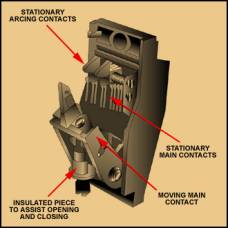
Figure
9. Contact Assembly Mounted (Rear View)
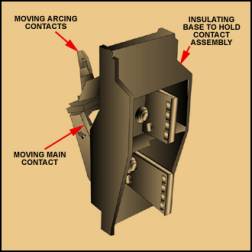
 Arc
Extinguishers:
Arc
Extinguishers:
Low
voltage power circuit breakers use some type of Arc
Extinguishers
(arc chutes or arc chambers) mounted above and around the main contacts to
extinguish arcs in air (Figure 21 ). This leads to the name low voltage power
air circuit breakers.
Figure
10. Top Rear View Magnum DS Circuit Breaker Showing
Arc Chambers and One Arc Chute Removed
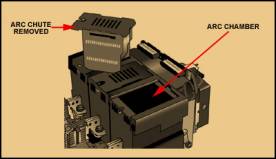
 Operating
Mechanism:
Operating
Mechanism:
The mechanism
is a two-step spring charged stored energy type
providing three basic functions:
- A means to charge the
closing springs
- A means to close/open
the circuit breaker using the stored energy of the closing and opening
springs
- A means to perform an
Open-Close-Open duty cycle
 Two
varieties of the mechanism exist:
Two
varieties of the mechanism exist:
- Manual
- Electrical (Motor
Operated)
1-Manual:
The manually
operated circuit breaker has its closing springs charged manually through
the use of some type of charging handle. The circuit breaker is closed using a
manual close button which is a mechanical process. As the circuit breaker
closes, a set of smaller opening springs are charged. The circuit breaker is
opened using a manual trip (open) button, which is a mechanical process.
2-Electrical
(motor operated):
An electrically
operated circuit breaker can be operated every way a manually operated
circuit breaker can be operated. In addition, a small electric motor is normally
used to automatically charge the closing springs, and an electrical means to
close or trip (open) the circuit breaker is provided.
 Integral
Trip Unit:
Integral
Trip Unit:
the
circuit breaker is a rather dumb device without a brain (intelligence source). This
source of intelligence is the trip unit
Figure12.
Integrally Mounted Trip Units
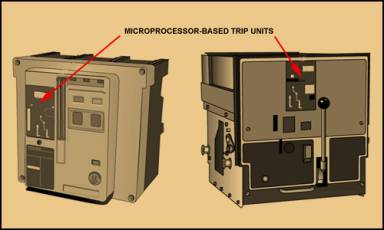
The
capabilities of a particular trip unit depends on the trip unit design itself
and system requirements. Some trip units can only offer basic features, while
others can offer basic features or, if required by the system, additional
sophisticated and highly advanced features.
 Accessory
Items:
Accessory
Items:
1-Electrical
Operator -
This is an assembly of devices including a small spring charging motor that when
added to a manually operated circuit breaker converts it
to an electrically operated circuit breaker. This allows for remote
operation (open/close) of the circuit breaker.
2-Operations
Counter - An operations counter is a counting device, usually linked in
some fashion to the operating mechanism. It is used to count
the open and close operations of the circuit breaker, and serves as a
maintenance aid.
3-Auxiliary
Switch - An auxiliary switch
consists of "normally open" (NO) and
"normally closed" (NC) contacts (Figure 13)
Figure
13. Graphical Representation of a Four Contact Auxiliary Switch (2A and 2B)
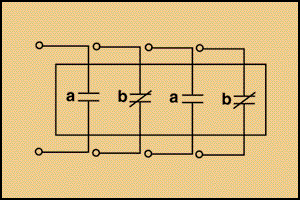
4-Undervoltage
Release (UVR) - An undervoltage
release, normally a circuit breaker mounted electromechanical device, trips the
circuit breaker when the voltage falls below a
predetermined level.
5-Shunt
Trip (ST) - A shunt trip is an
electromechanical device which is standard on most electrically operated power
circuit breakers. When added to a manually operated circuit breaker, it provides
for remote controlled electrical tripping.
6-Spring
Release (SR) -
The spring release device is standard on most electrically operated power
circuit breakers. When added to a manually operated circuit breaker, it permits
the circuit breaker to be closed electrically from a remote location